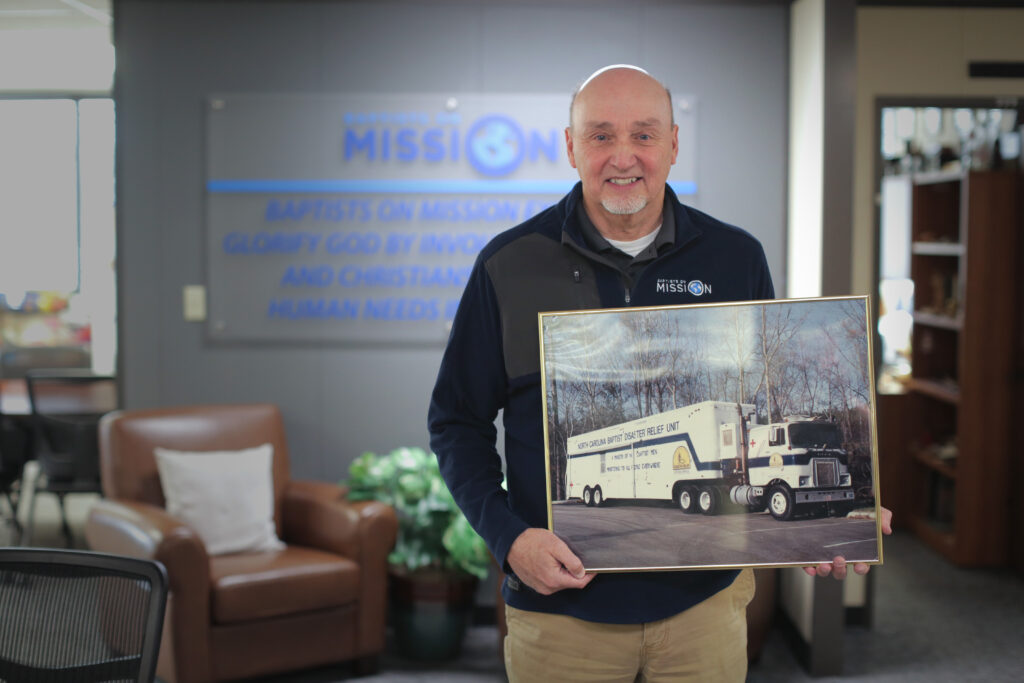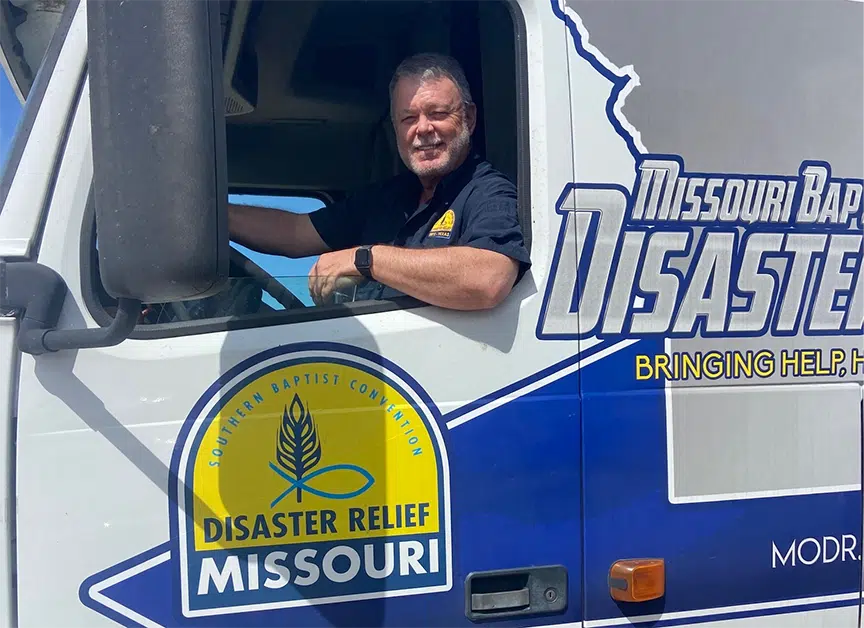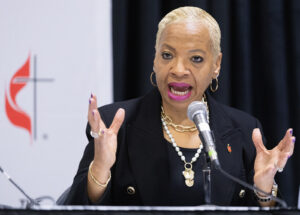
Baptist cooperative effort helps Texas ranchers feed their cows
By Jane Rodgers/Southern Baptist TEXAN
CANADIAN, Texas (BP) – A massive cooperative effort among Southern Baptist Disaster Relief state teams, including Southern Baptists of Texas Convention Disaster Relief, rushed 1,031 large round bales of hay in early March to areas devastated by recent Panhandle wildfires.
By March 21, plans to transport 1,200 more bales were also underway. As of Sunday, March 24, an additional 1,600 bales of hay have been made available pending the arrangement of transportation.
The hay relief effort – which has also included the North American Mission Board’s Send Relief, the Texas Salvation Army, and a major corporation – started when SBTC DR was contacted March 8 with a request for help. SBTC DR Director Scottie Stice was flummoxed. SBTC DR crews, along with other state SBDR teams, had hurried to the Panhandle even as the wildfires raged. Feeding, shower and laundry, and recovery crews were busy. But how would the team acquire and transport hay?
“We can’t handle this. We don’t have the equipment. We don’t have the time. We don’t have the people. We don’t have semi-trucks or trailers,” Stice remembered telling the Lord.
On March 10, Stice sat in Sunday school at Tabernacle Baptist Church in Ennis thinking of the desperate need for hay. He looked at the whiteboard where the substitute teacher had written, “Ask God.”
So Stice did.
“I read it twice. Then I prayed and asked God,” Stice said. “I sent off a text message to other state DR directors. Before Sunday school was over, we had received a promise of two semi-truck loads of hay from Kentucky Baptist DR.”
The effort gained momentum from there, with SBDR teams from Missouri, New Mexico, Illinois, Tennessee, Ohio, and Arkansas – in addition to Kentucky – promising to help.
“Farmers and ranchers across the various states are donating the hay, by and large,” Stice said.
Send Relief provided some hay loads and a grant to facilitate distribution efforts, he said. More trucks were still needed, so Stice contacted the Salvation Army Texas Division Emergency Disaster Services notifying them of the need.
“We’ve been waiting on your call,” Director Alvin Migues said.
Within a day, the Salvation Army sent two trucks, two drivers, and rented trailers to Arkansas to pick up hundreds of bales of hay and transport them to sites in Borger, Canadian, and Pampa designated as hay depots by Texas A&M AgriLife agents. The AgriLife agents then began coordinating with ranchers to distribute the hay where it was needed.
A large corporation requesting anonymity also sent three semis with trailers to Arkansas. The effort is ongoing.
“It’s been a huge cooperative effort meeting a real need in West Texas,” Stice said. “This illustrates how Baptist DR teams and like-minded organizations can partner to get the Lord’s work done.”
Texas is home to some 11 million head of cattle, more than 85% located in the Panhandle, according to the Texas Department of Agriculture. Tens of thousands of head were affected by the fires which burned more than a million acres.
“Pray God will provide a means for us to get the hay where it is vitally needed,” Stice said.
NC Baptist disaster response marks 40th anniversary
By Chad Austin/Biblical Recorder
RED SPRINGS, N.C. – Like many residents of Red Springs, Elnora Hollingsworth will never forget what March 28, 1984, was like or the events that took place that day.
“It was a beautiful day,” Hollingsworth remembers. “Just so calm.”
But it was the calm before the storm.
Hollingsworth was returning home from supper at a seafood restaurant just a few miles outside of town when she learned that a tornado had ripped through the region.
“We didn’t know anything had happened until we drove up to the first stoplight,” Hollingsworth said. “There was a gas tanker sitting there, and the driver was screaming, yelling at us not to go any further. He said, ‘I think a tornado has hit this town.’”

The twister that tore through Red Springs in Robeson County at approximately 7:30 p.m. that evening was part of the deadliest and most destructive tornado outbreak in the history of the Carolinas. All told, the band of storms that swept across the South that day produced a total of 24 confirmed tornadoes – 11 in North Carolina, 11 in South Carolina and two in Georgia – that collectively resulted in 57 deaths, more than 1,200 injuries and millions of dollars in damage.
The storm system impacted numerous counties across southeastern and eastern North Carolina as it moved more than 200 miles in a northeasterly direction all the way from the Sandhills to the Outer Banks. Red Springs was among the hardest hit places in the state as the storm ravaged the town’s business district, leveled an elementary school, downed trees on streets and homes, and knocked out power and telephone service.
“It was like a battle zone,” said Dickie Nye, a lifelong Red Springs resident.
Yet the storm that caused so much devastation and destruction 40 years ago gave birth to a brand new ministry among N.C. Baptists that would ultimately grow to become one of the most visible in the state and beyond.
An emerging ministry
In the 1970s, N.C. Baptist leaders began exploring ways to engage in an emerging ministry in Baptist life – disaster relief. The first ever disaster relief response by any Baptist group came in 1967 when Texas Baptists assisted victims of Hurricane Beulah, a Category 5 storm that struck the Lone Star State.
With help from Texas Baptists, North Carolina was among a handful of states looking to begin its own ministry to respond to natural disasters.
By the early 1980s, N.C. Baptist Men, an auxiliary of the Baptist State Convention of North Carolina which is now known as Baptists on Mission, acquired a tractor trailer unit which was housed at Caraway Conference Center near Asheboro. On weekends, volunteers traveled to Caraway to work on outfitting the trailer with equipment so it could be deployed in the aftermath of a natural disaster.
The morning after the tornado hit Red Springs, N.C. Baptist Men received a call requesting assistance, which pressed the new disaster relief unit into service a little sooner than originally planned.
But by 6:30 p.m. on Thursday, March 29, 1984 – a little less than 24 hours after the tornado touched down and hours after receiving the call for help – the disaster relief unit and a team of N.C. Baptist volunteers set up shop at First Baptist Church of Red Springs, where they operated a mobile kitchen to prepare and serve hot meals to people in need.
Hollingsworth, a member of the church, was among those who helped serve meals.
“We just took turns helping out,” Hollingsworth said. “I remember we fed a lot of people. We were handing the food out as fast as we could hand it out. It was busy.”
Preparing and serving meals to those impacted by the tornado outbreak in Red Springs 40 years ago marked the very first disaster relief response by N.C. Baptists. Over the coming decades, the ministry would grow to encompass much more, with teams and equipment deploying to assist people impacted by natural disasters near and far.
















